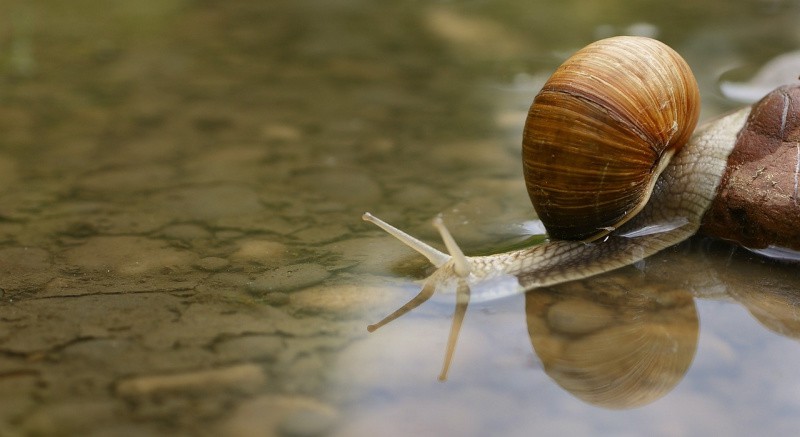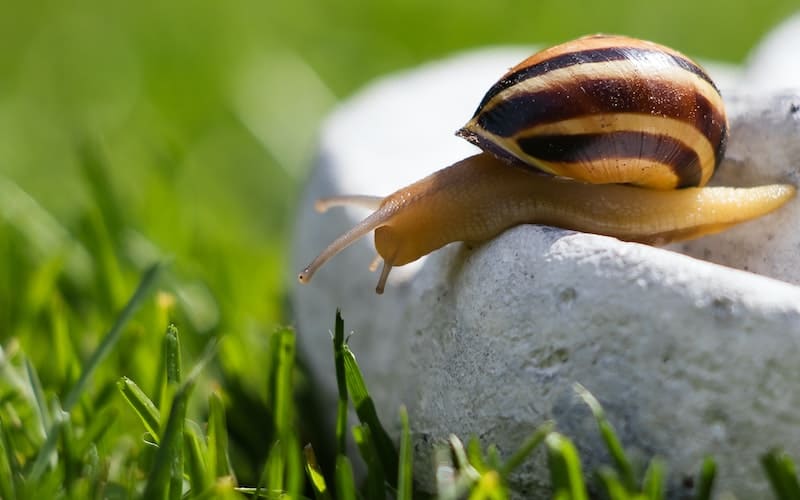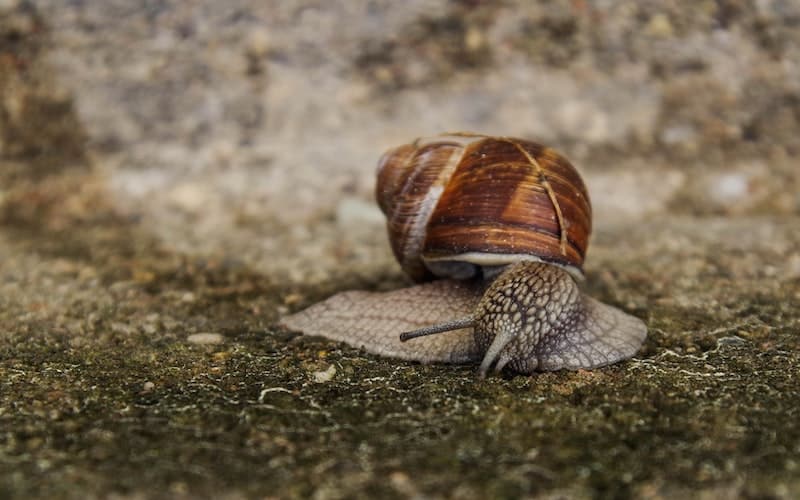Last Updated on September 16, 2023 by ellen
Can snails breathe underwater? Find out more about what snails breathe and other interesting snail facts.
Posts may be sponsored. This post contains affiliate links, which means I will make a commission at no extra cost to you should you click through and make a purchase. As an Amazon Associate I earn from qualifying purchases.
Table of Contents
Can Snails Breathe Underwater?
Do you know how snails breathe? Whether you are interested in pond snails, aquatic snails, land snails or mystery snails, they all breathe.
Both sea snails and freshwater snails live underwater. And, as their name suggests, they can breathe underwater using gills or a lung.
The pond snail stores air in a pallial cavity and uses it while underwater to breathe. Pond snails are unique in this way.
Land snails or terrestrial snails breathe oxygen. An example of this type of snail is a garden snail. They are not sea creatures and cannot breathe underwater like sea snails or freshwater snails.
Different snails need different habitats. It’s important to know which type of snail you are keeping as a pet. This guide is so helpful.
How long can snails breathe underwater?
Snails’ ability to breathe underwater largely depends on their species. Pond snails, for instance, can stay submerged indefinitely due to their special adaptation to store and use air. Their biological make-up allows them to extract oxygen from the air pocket they carry along, thus making it possible for them to breathe underwater for long periods.
However, it’s important to note that not all snails have the same ability. Land snails, as opposed to aquatic snails, cannot breathe underwater at all. They breathe air, much like humans, and they do this through a lung-like organ known as a pallial lung.
In conclusion, snails are fascinating creatures with diverse respiratory systems. While some can breathe underwater indefinitely, others need to surface for air. So, the duration that a snail can breathe underwater varies greatly among different species, and it’s a captivating testament to the adaptability of these small but fascinating creatures.
If you are considering pet snails, most people choose land snails like garden snails. These land snails breathe oxygen and live in a terrarium. They are air breathing snails.
Do water snails need air?
Yes, water snails do need air. Even though they live underwater, they require oxygen to survive. Some kinds of water snails have developed the ability to breathe underwater using gills, while others surface to access the air. The fact that these snails have gills, shows the remarkable adaptability of snails to their environment.
What happens if you put a snail in water?
Placing a land snail in water can result in different outcomes depending on the duration of the submersion and the type of the snail. If you were to put a land snail in water for a brief moment, it might not be harmful. The snail could close up its shell and wait for the environment to change.
However, if a land snail is submerged in water for an extended period, it could be fatal. This is because land snails, unlike their aquatic counterparts, are not equipped to breathe underwater. They possess a lung-like organ, not gills, which they use to take in oxygen directly from the air. Extended periods underwater can lead to suffocation.
In a nutshell, while water is vital to the survival of snails – they need it to keep their bodies moist and facilitate mobility – too much water, particularly in the form of immersion, can be harmful. Land snails are not adapted to live in water and could possibly drown if submerged for too long. It’s always best to understand the specific needs and living conditions of your snail species to ensure you’re providing the appropriate habitat for them.
Can garden snails live in water?
Garden snails, like other land snails, are not designed to live in water. They are adapted to terrestrial life and have a lung-like organ that allows them to breathe air, not gills for breathing underwater. So while they can survive a short time in water while sealed inside their shells, a prolonged stay in water is not suitable for them and could lead to suffocation and death.
So, if you’re considering keeping garden snails as pets, remember that their natural habitat is on land, not in water. To replicate their natural environment, provide them with a damp, not drenched, environment and plenty of places to hide. This will ensure they stay healthy and can breathe properly. It’s always best to research and understand the specific needs of your snail species to provide the proper care and environment for them.
Can garden snails swim?
While garden snails are not natural swimmers and do not have the adaptations to live underwater, they can move in water by using their muscular foot to do a sort of ‘doggy paddle’. However, this is not truly swimming and they cannot stay afloat or survive in water for extended periods. Therefore, it’s fair to say that garden snails can’t swim in the same way that aquatic animals can.
What are lunged snails?
Lunged snails, also known as pulmonate snails, are a type of snail that has a unique respiratory feature – a lung. Instead of gills that many aquatic creatures have for extracting oxygen from water, these snails have a lung-like organ. This lung-like structure, known as a pallial lung, allows them to breathe air, similar to the way humans and other land animals do.
The pallial lung is an adaptation to life on land, making these snails terrestrial creatures. This lung is located in the mantle cavity of the snail, an inner space in the shell. When the snail extends its body out of its shell, it opens a breathing pore to allow air into this lung. This ability to breathe air is why you see many of these snails in gardens, forests, and other land environments rather than in the water. Despite their adaptability, lunged snails still need a moist environment to prevent their bodies from drying out.
What snails breathe with gills?
Aquatic snails breathe underwater. Aquatic snails, both freshwater and sea snails, are the types that breathe using gills. These species are adapted to life underwater and possess gills that allow them to extract oxygen directly from the water they are living in.
This enables them to remain submerged indefinitely without needing to surface for air. Different species of aquatic snails, such as apple snails, mystery snails, and nerite snails, all possess this gill-breathing capability. These gilled snails are a stark contrast to lunged snails, who need to breathe air and cannot survive underwater for long periods.
Can mystery snails drown?
Mystery snails, like other aquatic snails, have gills which allow them to breathe underwater. This makes it possible for them to stay submerged indefinitely without needing to surface for air. However, mystery snails also have a siphon – a sort of snorkel – which they can extend above the water’s surface to draw in air when needed. While they are well-adapted to life underwater, if the water quality is poor or oxygen levels are too low, they may suffer. But generally, under normal conditions, mystery snails will not drown.
Now that you know whether snails breathe underwater, you may want to keep snails as pets.
Related Reading

Ellen runs a small pet sitting business in southern Vermont. She has experience with a variety of small animals, dogs and cats. She has also cared for ducks, chickens and rabbits. Combined, she has over 20 years of experience in pet care and pet sitting.




